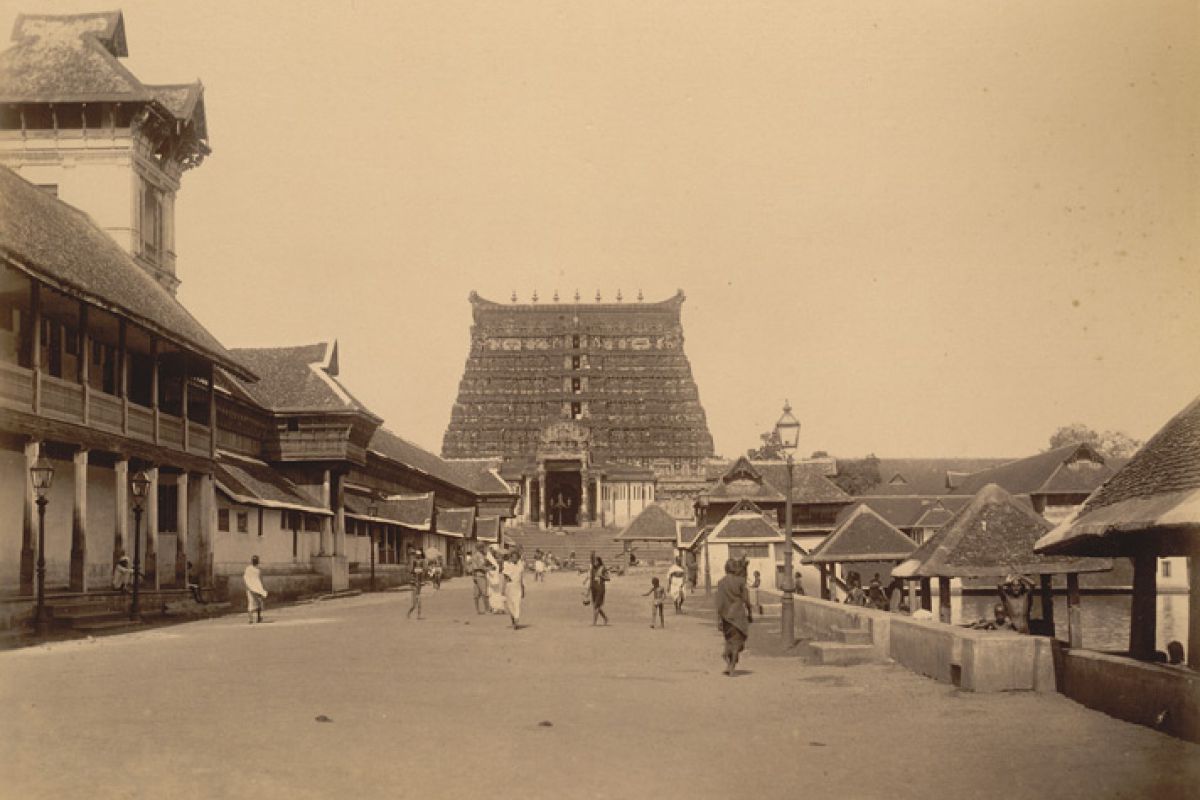History of Sree Padmanabhaswamy Temple in Thiruvananthapuram
History & Legends of Sree Padmanabhaswamy Temple in Thiruvananthapuram

Thiruvananthapuram
Padmanabha Temple
Legends of Padmanabhaswamy Temple
T
he origin of this temple is lost in antiquity. No historical evidence available from on who consecrated the idol of Sree Padmanabhaswamy.The legends of the temple are handed down through the centuries. According to the traditional knowledge, the original temples is believed to consecrated on the first day of Kali Yuga (about 5000 years ago) by by a Tulu Brahmin hermit named Divakara Muni.
On the 950th year of Kali Yuga a reinstallation of the idol was done.
On the 960th year of Kali Yuga, King Kotha Marthandan built the Abhisravana Mandapam..
However the temple has many reference in Epics and Puranas.
Srimad Bhagavatha says that Balarama visited this Temple, bathed in Padmatheertham and made several offerings.
History of Padmanabhaswamy Temple
The earliest definite mention of the temple dates to the 9th century.
9th Century : Nammalwar, 9th century poet and one among the 12 Vaishnavite saints of the Alvar tradition, has composed ten hymns in praise of Lord Padmanabha.
Year 1050 AD: Records of the Temple reconstruction. Temple management re-organized by the then ruler.
Year 1335 AD: Sree Padmanabhaswamy Temple under the administration of the Venad king, Veera Marthanda Varma. The earliest mention of Alpasi Utsavam, the ten days annual festival of Sree Padmanabhaswamy Temple.
15th Century :A 15th century palm leaf record mentions the roof of sanctum sanctorum was repaired. The Ottakkal Mandapam (the single stone pavilion) in side the Padmanabhaswamy Temple in 15th century..
1459 AD: The idol of Sree Padmanabhaswamy was removed to a ‘Balalaya’ ( a little temporary shrine) for the purpose of re-construction of the roof of the sanctum sanctorum.
1461 AD: The idol re-installed in the sanctorum and the Ottakkal Mandapam (Single granite stone slab in front of the sanctum sanctorum) installed.
1566 AD:Foundation was laid for the Gopuram over the main eastern entrance, the most imposing structure of the temple seen today.
1686 AD: Most of the temple was destroyed in a major fire accident. Work on the renovation of the Temple was started only in 1728 after propitiatory ceremonies.
1728 AD: Marthanda Varma became the king of Travancore. He took the steps to renovate the Temple. The wealth of the temple started accumulating from this period.
Originally, most of the temple's structures was made of teak wood work, the was destroyed in fire. The renovation replaced the erstwhile wooden structures with granite in order to mitigate fire susceptibility. Otherwise the layout and design was not altered during the renovation.
1730 AD: The idol of Sree Padmanabhaswamy was moved to ‘Balalaya’ for two years for the reconstruction of the sanctum sanctorum.
The old wooden idol was replaced by the one that you see today. The idol is made of highly a complex amalgam known as 'Katusarkarayogam'. The compound contains 12008 Salagrams (from Nepal's Gandaki River). Most of what you see today within the walls of the temple were constructed during this renovation period.
You can walks along the 356 pillars corridor pavilion called Sreebalippura around the sanctum area. This was constructed during this period. About 4000 sculptors, 6000 labourers and 100 elephants worked for 6 months to construct the Sreebalippura.
The eastern 7 storied gopuram for which the foundation had been laid in 1566, was completed during this period.
Dhwaja Stambham ( flagstaff) in front of the main shrine was also installed at this time. Teak wood of required size was brought from the forest for this purpose and transported to the Temple, without the wood ever touched the ground.The 80 feet Dhwaja Stambham was then covered completely with gold sheets. Garuda, the sacred bird who carries Lord Vishnu is carved on the top of the flagstaff.
The renovation of Padmatheertham ( the Temple tank) and the steps leading to it, as you see today was done during this period.
1750 AD: After the major renovations, in 1750, the ten Travancore ruler Anizham Thirunal Maharaja, accession to the throne, dedicated his kingdom to the lord, in the Thrippadidanam ceremony.
On 17 January 1750, Anizham Thirunal surrendered the Kingdom of Travancore to Padmanabhaswamy, and pledged that he and his descendants would be vassals of deity.They would serve the kingdom as Padmanabha Dasa, on behalf of the Padmanabhaswamy
The name of the city of 'Thiruvananthapuram' in Malayalam and Tamil translates to "The City of Lord Ananta" (The City Of Lord Vishnu).
1750 AD: The pillared outdoor hall – Karthika Mandapam, was built by king Karthika Thirunal Rama Varma.
1820 AD: During the time of queen Gowri Parvathi Bayi, the large Anantha Shyana mural was drawn.
1936 AD: During the reign of Chithira Thirunal Rama Varma, he outlined the Kshethra Praveshan Vilambram (Temple Entry Proclamation). This Proclamation allowed anyone who profess the Hindu faith entry into the temples of Travancore.
